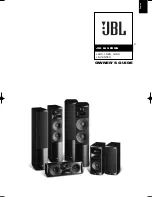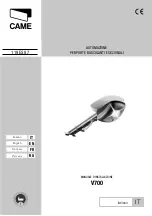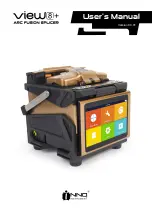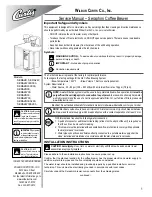
36
Ensure the cooling unit is switched off before dis-
connecting the pipes of the cooling liquid. The hot
liquid coming out of the pipes might cause burning
or scorching.
Keep a first aid kit ready for use.
Do not underestimate any burning or injury.
Before leaving work, make the area safe, in order
to avoid accidental damage to people or property.
1.3 Protection against fumes and gases
• Fumes, gases and powders produced during the welding (cut-
ting) process can be noxious for your health.
Under certain circumstances, the fumes caused by welding
(cutting) can cause cancer or harm the foetus of pregnant
women.
• Keep your head away from any welding (cutting) gas and
fumes.
• Provide proper ventilation, either natural or forced, in the
work area.
• In case of poor ventilation, use masks and breathing apparatus.
• In case of welding (cutting) in extremely small places the
work should be supervised by a colleague standing nearby
outside.
• Do not use oxygen for ventilation.
• Ensure that the fumes extractor is working by regularly check-
ing the quantity of harmful exhaust gases versus the values
stated in the safety regulations.
• The quantity and the danger level of the fumes depends on
the parent metal used, the filler metal and on any substances
used to clean and degrease the pieces to be welded. Follow
the manufacturer's instructions together with the instructions
given in the technical sheets.
• Do not perform welding (cutting) operations near degreasing
or painting stations.
Position gas cylinders outdoors or in places with good ventila-
tion.
1.4 Fire/explosion prevention
• The welding (cutting) process may cause fires and/or explo-
sions.
• Clear the work area and the surrounding area from any flam-
mable or combustible materials or objects.
Flammable materials must be at least 11 metres (35 feet) from
the welding area or they must be suitably protected.
Sparks and incandescent particles might easily be sprayed
quite far and reach the surrounding areas even through
minute openings. Pay particular attention to keep people and
property safe.
• Do not perform welding (cutting) operations on or near con-
tainers under pressure.
• Do not perform welding or cutting operations on closed con-
tainers or pipes.
Pay particular attention during welding operations on pipes
or containers even if these are open, empty and have been
cleaned thoroughly. Any residue of gas, fuel, oil or similar
materials might cause an explosion.
• Do not weld (cut) in places where explosive powders, gases
or vapours are present.
• When you finish welding, check that the live circuit cannot
accidentally come in contact with any parts connected to the
earth circuit.
• Position a fire-fighting device or material near the work area.
1.5 Prevention when using gas cylinders
• Inert gas cylinders contain pressurized gas and can explode
if the minimum safe conditions for transport, storage and use
are not ensured.
• Cylinders must be secured in a vertical position to a wall or
other supporting structure, with suitable means so that they
cannot fall or accidentally hit anything else.
• Screw the cap on to protect the valve during transport, com-
missioning and at the end of any welding operation.
• Do not expose cylinders to direct sunlight, sudden changes
of temperature, too high or extreme temperatures. Do not
expose cylinders to temperatures too low or too high.
• Keep cylinders away from naked flames, electric arcs, torches or
electrode guns and incandescent material sprayed by welding.
• Keep cylinders away from welding circuits and electrical cir-
cuits in general.
• Keep your head away from the gas outlet when opening the
cylinder valve.
• Always close the cylinder valve at the end of the welding
operations.
• Never perform welding (cutting) operations on a pressurized
gas cylinder.
• A compressed air cylinder must never be directly coupled
to the machine pressure reducer. Pressure might exceed the
capacity of the reducer which could consequently explode.
1.6 Protection from electrical shock
• Electric shocks can kill you.
• Avoid touching live parts both inside and outside the welding/
cutting system while this is active (torches, guns, earth cables,
electrodes, wires, rollers and spools are electrically connected
to the welding circuit).
• Ensure the system and the welder are insulated electrically by
using dry bases and floors that are sufficiently insulated from
the earth.
• Ensure the system is connected correctly to a socket and a
power source equipped with an earth conductor.
• Do not touch two torches or two electrode holders at the
same time.
lf you feel an electric shock, interrupt the welding (cutting)
operations immediately.
Summary of Contents for Genesis 4000 MSE
Page 32: ...32...
Page 62: ...62...
Page 212: ...212...
Page 242: ...242...
Page 272: ...272...
Page 302: ...302...
Page 332: ...332...
Page 336: ...336 1 3 1 4 11 35 1 5...
Page 338: ...1 8 IP S IP23S 12 5 mm 60 2 2 1 2 2 10 2 3 400V 230V V 230 400V 338...
Page 339: ...339 15 15 2 1 5 2 4 MMA 3 4 1 2 WF ARC AIR 5 6 7 ARC AIR 8 9 TIG 10 11 TIG 12 13 14 15...
Page 341: ...341 8 9 64 3 3 3 4 LCD 1 2 3 1 m min 22 m min Default 1 0 m min 4 5 3 5 MMA TIG DC MIG MAG...
Page 354: ...5 6 Reset 354...
Page 355: ...355 encoder...
Page 356: ...356...
Page 357: ...357 7 7 1 MMA Hot Start Arc Force antisticking 7 2 TIG TIG Tungsten lnert Gas 3370 C H F lift...
Page 359: ...359 7 3 MIG MAG MIG SHORT ARC 1a SHORT a SPRAY ARC b SPRAY ARC 1b 2 3 2 3 1a 1b...
Page 366: ...366 GENESIS 4000 MSE 3x230 400V...
Page 367: ...367 GENESIS 4000 MSE LCD 3 5 LCD 4 7 3x400V...
Page 368: ...368 GENESIS 4000 MSE LCD 3 5 LCD 4 7 3x230 400V...
Page 369: ...369 GENESIS 5000 MSE 3x400V...
Page 370: ...370 GENESIS 5000 MSE LCD 3 5 LCD 4 7 3x400V...
Page 372: ...372 GENESIS 4000 MSE LCD 3 5 LCD 4 7 3x400V GENESIS 4000 MSE LCD 3 5 LCD 4 7 3x230 400V...
Page 373: ...373 GENESIS 5000 MSE 3x400V GENESIS 5000 MSE LCD 3 5 LCD 4 7 3x400V...
















































